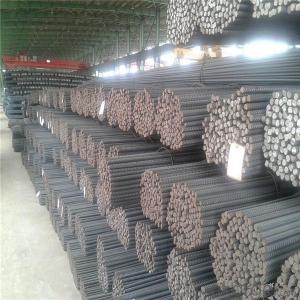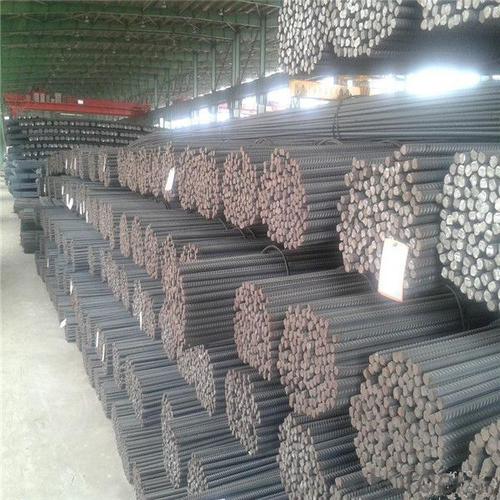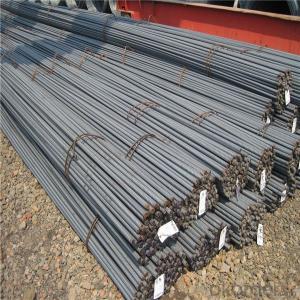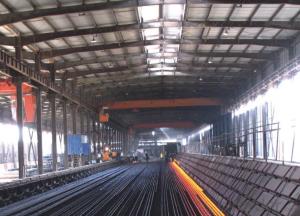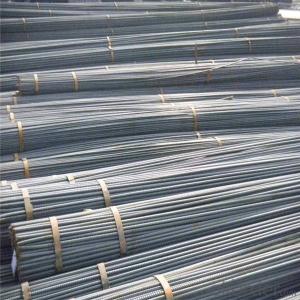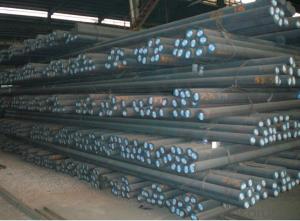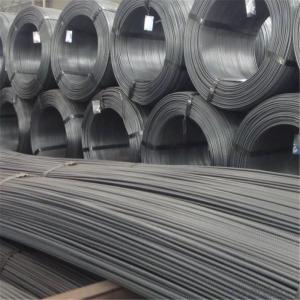Iron Rod and Reinforcing Steel Rebar 6-12m
- Loading Port:
- Tianjin
- Payment Terms:
- TT OR LC
- Min Order Qty:
- 100 m.t.
- Supply Capability:
- 18000 m.t./month
OKorder Service Pledge
OKorder Financial Service
You Might Also Like
Specification
Steel rebar is bars of steel commonly used in construction, especially for reinforcing concrete structures such as driveways,
foundations, walls, and columns. These bars come in different sizes and strength grades, and can be smooth or may include
deformations that provide greater adhesion for concrete poured over the bars. When used in poured concrete, the bars are typically
placed in a grid pattern, the concrete poured over them, and then readjusted to maintain the proper shape while the concrete sets.
Steel rebar can be purchased from a number of manufacturers and is often found at construction retailers or large hardware stores.
Our Advantage: High quality steel products from 1 class mills in China
Reasonable price
Professionalism of the products
On-time delivery
Complete documents and certificates
Sincere service to meet our clients' requirements
Product Description :
Chemical composition (%): | Steel | C | Si | Mn | P | S | Ceq | ||||
HRB335 |
0.25 |
0.80 |
1.60 |
0.045 |
0.045 | 0.52 | |||||
HRB400 | 0.54 | ||||||||||
HRB500 | 0.55 | ||||||||||
Mechanical properties | Steel | Rel/ MPa | Rm/ MPa | A/ % | Agt/ % | ||||||
≥ | |||||||||||
HRB335 | 335 | 455 | 17 |
7.5 | |||||||
HRB400 | 400 | 540 | 16 | ||||||||
HRB500 | 500 | 630 | 15 | ||||||||
Package: | Standard export packing or as customer's request | ||||||||||
Application: | Construction, building, bridge, road. ect | ||||||||||
Payment terms | 1).100% irrevocable L/C at sight. | ||||||||||
Delivery time | 15-30 days after receipt of L/C or deposit by T/T | ||||||||||
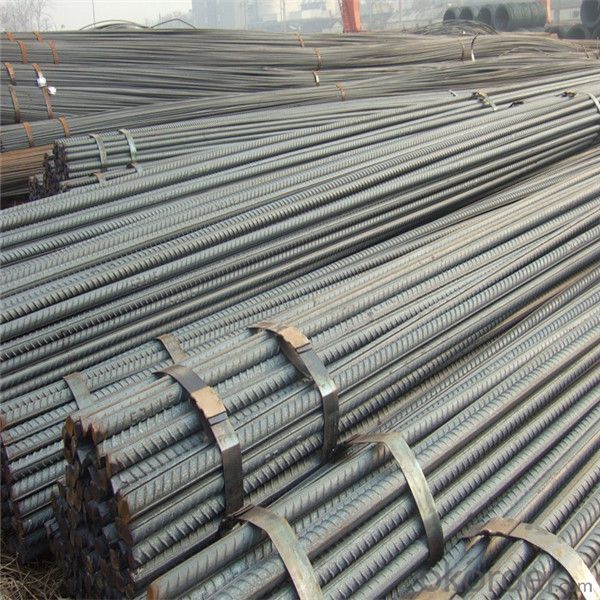
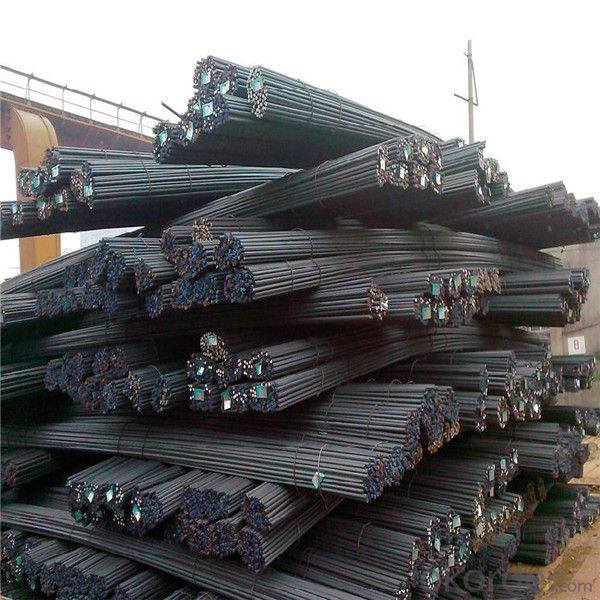
Packing:
In bundles, each bundle weight 3.5 tons. Load by container or by bulk verssel.
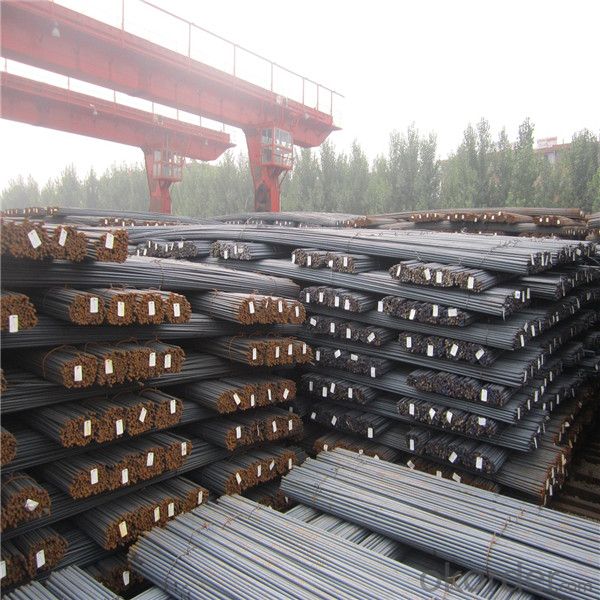

Our service
(1) We cooperate with famous factories with advanced equipment and well trained workers.
(2) We can provide factory price with trading company service.
(3) We continuously work on the improvement of our processes, guaranteeing consistently high standards
of quality to keep none compensation.
(4) We guarantee 24 hours response and 48 hours solution providing service.
(5) We accept small order quantity before formal cooperation.
(6) We deliver the agreed quality at the agreed time, reacting to changes in customer wishes in a flexible way.
(7) Due to our volume and selling power, we have excellent freight rates with shipping lines.
(8) We strive to always be fair and honest in our dealings with customers.
(9) We strive to work together with customers to achieve much more than we can achieve alone.
(10) Through our passion and commitment we aim to be a market leader in all our key markets. To maintain
our position as market leader we must continue to add value in all that we do.
FAQ:
1.Q: What's your MOQ(minimum order quantity)?
A: One full container, mixed acceptable .
2. Q: What's your packing methods?
A: Packed in bundle or bulk ..
3. Q: How can I buy CNBM products in my country?
A:Please send us an inquiry or email ,we will reply to you if there is distributor in your country
4. Q: Can we visit your factory?
A: Warmly welcome. Once we have your schedule, we will arrange the professional sales team to follow up your case.
5. Q: How long does it take to get the product if i place an order?
A:With the process of your requirements,we will pack and deliver in 3-7 days. If it is by sea shipment,it will take 15-45 days depending on different locations
- Q: Can steel rebars be used in the construction of government buildings?
- Yes, steel rebars can be used in the construction of government buildings. Steel rebars are commonly used in construction due to their high strength and durability, making them suitable for various building types, including government buildings. They provide reinforcement to concrete structures, increasing their load-bearing capacity and structural integrity, which is essential for the safety and longevity of government buildings. Additionally, steel rebars comply with industry standards and building codes, ensuring that the construction meets the necessary regulations and requirements.
- Q: What are the guidelines for preventing steel rebars from rusting during construction?
- To prevent steel rebars from rusting during construction, there are several guidelines that can be followed. These include: 1. Proper storage: Steel rebars should be stored in a dry and covered area to protect them from moisture. They should be kept off the ground and away from any sources of water, such as puddles or wet concrete. 2. Surface preparation: Before installation, rebars should be inspected for any signs of rust or corrosion. If any are found, they should be cleaned using a wire brush or sandblasting to remove the rust and create a clean surface for proper adhesion. 3. Coating: Applying a protective coating to the rebars can help prevent rusting. This can be done using epoxy, zinc, or other anti-corrosion coatings. The coating should be applied evenly and in accordance with the manufacturer's instructions. 4. Proper spacing: When placing rebars in concrete, it is important to ensure that they are adequately spaced to allow for proper ventilation and prevent moisture from being trapped between them. The spacing should be as per the design specifications or as recommended by structural engineers. 5. Adequate concrete cover: The rebars should have an adequate concrete cover to protect them from moisture and corrosion. This cover thickness should be as per the design requirements and should be maintained during construction. 6. Proper curing: After installation, the concrete should be properly cured to ensure it reaches its maximum strength and durability. Proper curing methods, such as using curing compounds or covering the concrete with plastic sheeting, can help prevent moisture penetration and rusting of the rebars. 7. Regular inspections: Regular inspections of the rebars should be conducted during construction to identify any signs of rust or corrosion. If any are found, appropriate measures should be taken to address the issue promptly and prevent further damage. By following these guidelines, construction professionals can minimize the risk of steel rebars rusting during construction, ensuring the structural integrity and longevity of the project.
- Q: Why is the threaded steel thread?
- Steel is commonly known as hot rolled ribbed bar, belonging to the small steel steel, mainly used for steel reinforced concrete structure frame. In use, some mechanical strength, bending deformation property and welding performance are required.
- Q: What is the process of bending steel rebars into shapes other than straight bars?
- The process of bending steel rebars into shapes other than straight bars involves several steps and techniques. Firstly, the rebars need to be measured and marked to indicate the desired bending points and angles. This is usually done using a measuring tape, a square, and a marker. Next, the rebars are secured in a bending machine or a manual bending tool. The bending machine consists of two main components - a bending head and a bending table. The rebars are placed on the bending table, and the bending head is adjusted to the desired angle and position. Once the rebars are securely positioned, the bending process begins. For smaller rebars, manual tools such as a rebar bender or a rebar cutter can be used. These tools allow the worker to apply force and bend the steel rebar to the desired shape. For larger rebars or complex shapes, a hydraulic bending machine is often employed. This machine uses hydraulic pressure to bend the rebars, allowing for greater precision and control. The operator can adjust the angle and radius of the bend to achieve the desired shape. During the bending process, it is important to ensure that the rebars are not overstressed or damaged. Excessive bending can weaken the rebars and compromise their structural integrity. Therefore, it is crucial to follow the bending specifications and guidelines provided by engineers and construction standards. After the rebars have been bent to the desired shape, they are typically inspected for any defects or imperfections. This is done to ensure that the rebars meet the required standards and can be safely used in construction projects. In conclusion, the process of bending steel rebars into shapes other than straight bars involves measuring and marking, securing the rebars in a bending machine, applying force or hydraulic pressure to bend the rebars, and inspecting the final product for quality assurance. This process requires precision, skill, and adherence to safety guidelines to ensure the rebars can withstand the intended structural loads.
- Q: How do steel rebars contribute to the overall safety of a structure?
- Steel rebars contribute to the overall safety of a structure in several ways. Firstly, they provide reinforcement to concrete, which is a brittle material and prone to cracking under tension. By embedding steel rebars within the concrete, the structure gains enhanced tensile strength, allowing it to withstand greater loads and resist cracking or failure. Secondly, steel rebars help to distribute and dissipate stress throughout the structure. When a load is applied to a structure, such as an earthquake or heavy winds, it creates internal forces that need to be managed and dispersed. Steel rebars act as a network of interconnected bars, transferring the load from one rebar to another, and eventually to the foundation. This helps to prevent localized stress concentrations and ensures that the structure can better withstand external forces. Moreover, steel rebars improve the ductility of a structure. Ductility refers to a material's ability to deform without breaking. When a structure is subjected to extreme forces, such as seismic activity or high winds, it needs to be able to flex and absorb energy without collapsing. Steel rebars provide this ductility by elongating and deforming under stress, absorbing and dissipating energy before reaching a critical point of failure. This characteristic makes steel rebars crucial in protecting the overall integrity of the structure and ensuring the safety of its occupants. Furthermore, steel rebars also contribute to the long-term durability of a structure. Concrete is susceptible to various environmental factors, such as moisture, temperature fluctuations, and chemical exposure, which can lead to deterioration and weakening over time. By reinforcing the concrete with steel rebars, the structure becomes more resistant to these factors and maintains its strength and stability for a longer period. In conclusion, steel rebars play a vital role in ensuring the overall safety of a structure. They enhance the tensile strength of concrete, distribute stress, improve ductility, and increase the durability of the structure. By providing these essential properties, steel rebars greatly reduce the risk of structural failure and protect the lives and well-being of those within the building.
- Q: Can steel rebars be used in lightweight concrete construction?
- Yes, steel rebars can be used in lightweight concrete construction. In fact, they are commonly used to reinforce lightweight concrete structures such as walls, beams, and columns. The addition of steel rebars provides tensile strength to the concrete, making it more resistant to cracking and structural failure. Lightweight concrete, which typically has a lower density than traditional concrete, can benefit from the use of steel rebars as they help to counteract the lower strength and reduce the risk of deformation under load. However, it is important to choose the appropriate size and spacing of rebars based on the specific requirements and design of the lightweight concrete structure.
- Q: What are the different methods of connecting steel rebars together?
- The connection of steel rebars can be achieved through various methods, depending on the specific needs of the construction project. Here are some commonly used techniques: 1. Lap Splicing: This method involves overlapping two rebars and securing them together using steel wire or bars. It is a cost-effective approach, although it requires longer rebars. 2. Mechanical Splicing: By using a mechanical coupler such as a sleeve or collar, two rebars can be connected. This method offers a strong and reliable connection and allows for flexibility in rebar positioning. It is faster and more efficient than lap splicing. 3. Welding: Steel rebars can be connected by heating and fusing their ends together using an electric arc. This creates a permanent and robust connection. However, welding demands skilled labor and can be time-consuming and expensive. 4. Threaded Couplers: Similar to mechanical splicing, this method involves threading the ends of rebars and connecting them using a threaded coupler. It provides a reliable connection and is commonly used in larger construction projects. 5. Grout Sleeve Splicing: This technique incorporates a grout-filled sleeve between two rebars to establish a connection. The grout enhances strength and stability, making it suitable for seismic zones or areas requiring high strength and ductility. 6. Reinforcing Bar Couplers (RBC): RBC is a proprietary method that employs a threaded sleeve filled with epoxy resin to connect rebars. It offers high load capacity, ease of installation, and resistance to corrosion. To determine the most appropriate method for connecting steel rebars in a specific construction project, it is crucial to consult structural engineers and adhere to building codes and regulations.
- Q: How are steel rebars labeled or marked for identification?
- Steel rebars are typically labeled or marked for identification using specific symbols or codes that indicate important information such as the manufacturer, grade, size, and type of rebar. This labeling or marking is usually done through embossing, paint, or tags attached to the rebar.
- Q: How are steel rebars manufactured and processed?
- Steel rebars, also known as reinforcing bars, are manufactured and processed through a series of steps. The process begins with the melting of raw materials, such as iron ore and scrap metal, in a furnace to produce molten steel. This molten steel is then cast into billets or blooms, which are further processed through rolling mills to form long, thin rods with a specific diameter. These rods are then cut into desired lengths and undergo a process called quenching and tempering, which involves rapid cooling and reheating to enhance their strength and durability. Finally, the rebars are inspected, marked with identification numbers, and packaged for distribution to construction sites, where they are used to reinforce concrete structures.
- Q: 16 meters of thread steel, how many meters?
- Hot rolled ribbed bar is divided into two levels, HRB335 (old No. 20MnSi), three HRB400 (20MnSiV, 20MnSiNb, old No. 20Mnti), four grade HRB500 three grade.
Send your message to us
Iron Rod and Reinforcing Steel Rebar 6-12m
- Loading Port:
- Tianjin
- Payment Terms:
- TT OR LC
- Min Order Qty:
- 100 m.t.
- Supply Capability:
- 18000 m.t./month
OKorder Service Pledge
OKorder Financial Service
Similar products
Hot products
Hot Searches
Related keywords
